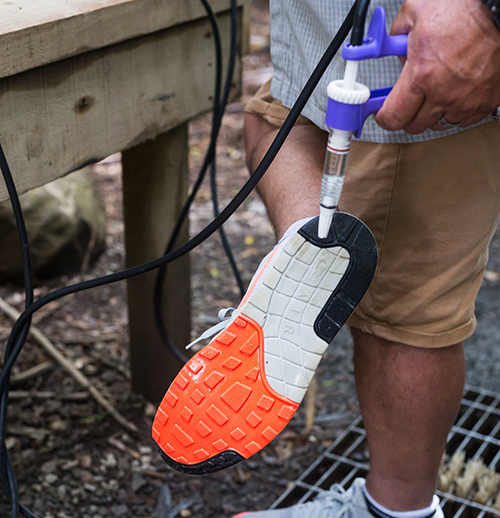Walking, running or tramping
Kauri are under threat from disease, commonly know as 'kauri dieback'. Humans are the number one way in which the disease is spread, through the movement of contaminated soil. But by taking the time to clean, and by factoring in kauri protection when planning your trip, responsible walkers/trampers like you are helping save kauri, along with the rest of the community.

How to guidelines
- Keep a cleaning kit in your vehicle that includes brushes, an adequate supply of Sterigene, and plastic bags for bagging any gear that can’t be cleaned on- site. To avoid spreading contaminated soil inside your vehicle, pack a second pair of footwear for the drive home.
- Clean all soil off your footwear and other gear (including hiking poles, clothing and bags), every time you enter or leave an area with native trees. This is to avoid introducing the disease to a new area, or moving it from an area where the disease is. A pinhead of soil is enough to spread the disease. Do not use water (including stream water) to clean, unless it will be captured in a sewer, for instance – the pathogen that causes dieback is a water mould, and is activated by water.
- Use disinfectant only after you have removed all the soil. Spray it on all the areas that have come into contact with the ground.
- If you are running, clean your gear before you do any stretching, so you don’t risk injury by allowing yourself to cool down. Likewise, do your post-run stretches before the cleaning stations. Be prepared to encounter cleaning stations on route, and use them.
- Avoid going off track, and going near kauri - unless the track is board-walked (a kauri’s roots are extremely delicate, are susceptible to disease, and can grow outwards 3x as far as a tree’s branches).
- Carry a brush and disinfectant at all times (Sterigene is available for purchase from most vet clinics) if you are going to be going off track, if you are using tracks that do not have cleaning stations, or if you will be crossing multiple catchments. If possible, clean your gear between catchments; i.e. between – but not in - rivers or streams, or between valleys.
- If you use hiking poles, use rubber feet on your poles to minimise the amount of soil your poles pick up.
- When you’re buying new footwear, consider how easy it will be to clean - is there a better option?
- Never assume anywhere is free of kauri dieback. Infected trees may not show it.
- Spread the word within your networks about the need for walkers, runners, and trampers to help stop the spread of kauri dieback, and be seen doing the right thing. Everyone has a part to play in saving kauri.
- If an area has been closed or is protected by a rahui, do not use it. Closures are only made when the risk of spreading the disease from an area is extremely high, or because that area is at extraordinary risk.
National plan to protect kauri
From 2 August 2022 ten new rules/regulations have been introduced as part of a national plan to help protect kauri from the Phytophthora Agathidicida (PA) pathogen that causes ‘dieback’ disease.
More information on the Plan and how it may affect your visit.
Disclaimer
This resource will be updated in the coming months, with new resources to be developed. Last updated: March 2017.
The information in this guide is intended to be general information. It is not intended to take the place of, or to represent, the written law of New Zealand or other official guidelines or requirements. While every effort has been made to ensure the information in this document is accurate, the Ministry for Primary Industries (and any of their employees or agents involved in the drafting of this guide) do not accept any responsibility or liability for any error of fact, omission, interpretation or opinion which may be present, nor for the consequences of any decisions or actions based on this information.
The Ministry/The Kauri Protection Programme itself and on behalf of all the persons mentioned above, clarifies that it has no control over and is not responsible for the contents of any pages referenced or accessed from this guide other than pages provided by the Ministry/The Kauri Protection Programme. Any hyperlinks to other Web sites imply neither responsibility for, nor approval of, the information contained in those other Web sites on the part of the Ministry/The Kauri Protection Programme.